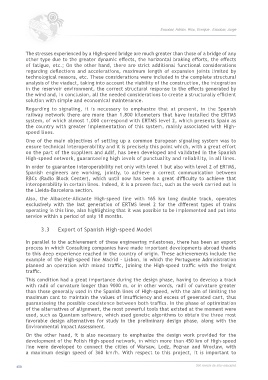Page 452 - 360.revista de Alta Velocidad - Nº 6
P. 452
Escobar, Adrián. Rico, Enrique . Escobar, Jorge
The stresses experienced by a High-speed bridge are much greater than those of a bridge of any
other type due to the greater dynamic effects, the horizontal braking efforts, the effects
of fatigue, etc.; On the other hand, there are strict additional functional considerations
regarding deflections and accelerations, maximum length of expansion joints limited by
technological reasons, etc. These considerations were included in the complete structural
analysis of the viaduct, taking into account the viability of the construction, the integration
in the reservoir environment, the correct structural response to the effects generated by
the wind and, in conclusion, all the needed considerations to create a structurally efficient
solution with simple and economical maintenance.
Regarding to signaling, it is necessary to emphasize that at present, in the Spanish
railway network there are more than 1,800 kilometers that have installed the ERTMS
system, of which almost 1,000 correspond with ERTMS level 2, which presents Spain as
the country with greater implementation of this system, mainly associated with High-
speed lines.
One of the main objectives of setting up a common European signaling system was to
ensure technical interoperability and it is precisely this point which, with a great effort
on the part of the suppliers and Adif, has been developed and validated in the Spanish
High-speed network, guaranteeing high levels of punctuality and reliability, in all lines.
In order to guarantee interoperability not only with level 1 but also with level 2 of ERTMS,
Spanish engineers are working, jointly, to achieve a correct communication between
RBCs (Radio Block Center), which until now has been a great difficulty to achieve that
interoperability in certain lines. Indeed, it is a proven fact, such as the work carried out in
the Lleida-Barcelona section.
Also, the Albacete-Alicante High-speed line with 165 km long double track, operates
exclusively with the last generation of ERTMS level 2 for the different types of trains
operating in this line, also highlighting that it was possible to be implemented and put into
service within a period of only 18 months.
3.3 Export of Spanish High-speed Model
In parallel to the achievement of these engineering milestones, there has been an export
process in which Consulting companies have made important developments abroad thanks
to this deep experience reached in the country of origin. These achievements include the
example of the High-speed line Madrid - Lisbon, in which the Portuguese Administration
planned an operation with mixed traffic, joining the High-speed traffic with the freight
traffic.
This condition had a great importance during the design phase, having to develop a track
with radii of curvature longer than 9000 m, or in other words, radii of curvature greater
than those generally used in the Spanish lines of High-speed, with the aim of limiting the
maximum cant to maintain the values of insufficiency and excess of generated cant, thus
guaranteeing the possible coexistence between both traffics. In the phase of optimization
of the alternatives of alignment, the most powerful tools that existed at the moment were
used, such as Quantum software, which used genetic algorithms to obtain the three most
favorable design alternatives for study in the preliminary design phase, along with the
Environmental Impact Assessment.
On the other hand, it is also necessary to emphasize the design work provided for the
development of the Polish High-speed network, in which more than 450 km of High-speed
line were developed to connect the cities of Warsaw, Lodz, Poznan and Wroclaw, with
a maximum design speed of 360 km/h. With respect to this project, it is important to
450 360.revista de alta velocidad

